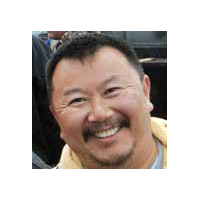
By John Chen–
What’s an active, outdoorsy, sports-oriented extrovert like me to do during a pandemic? I can’t in good conscience socialize with friends. I can’t attend fun events because that’s not safe. And I can’t play sports with my friends and go to the gym. Since the beginning of social distancing, I’ve hiked and walked everything in my neighborhood countless times. I’ve completed two home fitness programs in addition to using creative means to stay healthy and active. I’ve video chatted with friends and even watched Korean pro-baseball and the National Corn Hole Tournament (yes, this is a sport during a pandemic). After three and a half months, I fell into a rut. I am the type of person who needs both mental and physical motivation from a variety of stimuli or else I get bored.
What if I go on a road trip? Maybe I can steer away from urban centers and take this opportunity to see our country and check off some bucket list items. Maybe, in a small way, I can help contribute to our economy by supporting local businesses everywhere I go. But, is a road trip safe? Where can I and should I visit? What is open, allowed, and not allowed? What precautionary measures can I take to be even more safe?
After much research, I decided on a four-week road trip through 30 states. Luckily, my housemate, who is also a close buddy, very much wanted to go on this journey with me. It’s always more fun to road trip with a buddy. But buyers beware: you may either come out of this road trip closer or as mortal enemies. Choose your travel partner(s) wisely! Finally, I built some flexibility into my itinerary for just in case and contingencies.
Although a 28-day trip is lengthy, we packed light, mostly t-shirts and shorts, sundries, masks, sanitizers and wipes, Dude Wipes (you never know), sun block, bug spray, ibuprofen (life saver), Tide Pods and lots of quarters, and a cooler with re-freezable ice packs. We also printed hard copies of our itinerary with addresses and numbers for ourselves and for our relatives (just in case). Oh, I withdrew some cash, made sure my AAA membership is up to date, and took my car to the dealership for a multi-point inspection as well as fluid and filter replacement.
Now we are ready for the road trip of a lifetime! I have highlighted the interesting places and things we’ve seen, experienced, tasted, and learned, as well as tips for any potential road trippers!
July 5–8: Palm Springs, California
We started our road trip relaxing under the sun and puttering around the pool at a private Airbnb house in Palm Springs. Normally we would head to well-known great outdoors destinations such as Joshua Tree National Park and the Tramway. However, it was 105 degrees Fahrenheit by 11 am. Little did we know this would be considered cool compared to a few other stops on our trip!
I’ve been to Palm Springs more times than I can count and thought I’d share with you some beautiful hidden gems. Just south of Palm Springs lies a palm tree oasis, a canvas of lush green in the heart of Indian Canyon, and a tropical paradise in the middle of a desert. Just west of the city, up against the towering mountain is Tahquitz Canyon, home to a 40-foot water fall and where the Cahuilla Native American tribe once lived. When climate allows, I recommend a Cahuilla ranger-led hike to learn about their rich 5,000-year history with stories, beliefs, and way of life full of perseverance, ingenuity, fables, and intrigue.
July 8–10: Las Vegas, Nevada
Las Vegas needs no introduction. The original Sin City is all about what happens there, stays there. The million-dollar question, with a pandemic and social distancing rules, is: is it safe to visit Vegas? We were somewhat apprehensive staying in the Sin City for a couple of days, but quickly learned that visitors can have a safe time if they adhere to safety protocols: wear a mask, social distance, and sanitize.
Although shows, bars, and clubs were closed, we discovered Vegas still had enough to offer. Most restaurants, shops, casinos, and hotels were open and enforced safety rules. We spotted many security guards handing out masks and making sure people were wearing them. Even the pool areas had strict safety enforcements. We wore masks at all times, unless eating and swimming, used sanitizers stationed everywhere, and steered away from people in general. In essence, Las Vegas due to the pandemic had become a more wholesome, less sinful, but still worthwhile place to visit.
July 10–12: Zion and Bryce National Parks, Utah
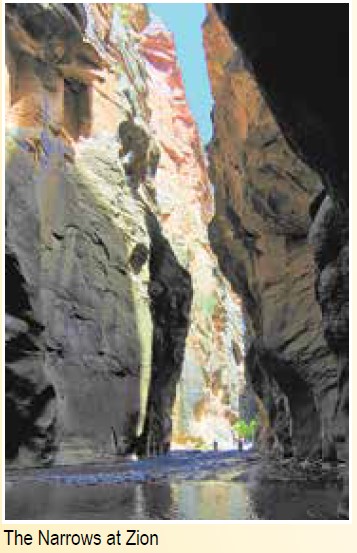
Bidding adieu to Vegas, we drove three hours north on I-15 to our next destination, Zion National Park. One of the most scenic and visited national parks, Zion offers some of the most iconic and sought-after hikes in the world with The Narrows presenting the greatest excitement, adventure, and challenge. It is a 9-mile (from the bottom up) round-trip hike in, yes in, the Virgin River that lies at the bottom of a deep and narrow canyon. The hike is considered easy, moderate, and strenuous depending on how far up the river you choose to hike. The further up the river you go, the harder the hike and the higher the reward. No matter how far you choose to go, the hike, in my humble opinion, is well worth the effort and one of my top bucket list to-dos.
Since successfully hiking The Narrows takes planning and preparation, I watched lots of YouTube videos and planned to go as far as I could physically. Due to the pandemic, Zion allowed very few personal vehicles to enter the Scenic Drive. In addition, shuttle tickets were extremely limited and sold out quickly in advance. We decided to rent e-bikes (reserved in advance) to tour the park, which turned out to be an excellent decision. We also got water hiking shoes, not water shoes, a dry bag to keep important things such as a wallet as well as food protected, water camera, and walking sticks. I can’t stress the importance of being well informed and prepared ahead of time to maximize our hiking experience. Looking back, hiking The Narrows was definitely the standout experience on our road trip.
Only 60 miles northeast of Zion is a lesser known, but every bit as stunning, national park: Bryce Canyon. The beautiful drive through the eastern span of Zion to Bryce is worth the price of admission. Words can’t paint the majestic red rock mountains and cliffs hugging the curvaceous highway. And words can’t describe the deep orange granite archways draped over the contrasting pavement.
Bryce Canyon Amphitheater is a dramatic panorama of bright orange rocks vertically stacked like a giant cauldron full of imperfectly shaped pillars. Although the view from the top is breathtaking, the trail, Navajo Loop leading to the bottom of the canyon, will surely satisfy your sense of awe and wonder. We hiked the Navajo Loop all the way to the canyon floor then back up in a series of steep switchbacks. The hike nearly killed me, but I proudly checked off another item on my bucket list.
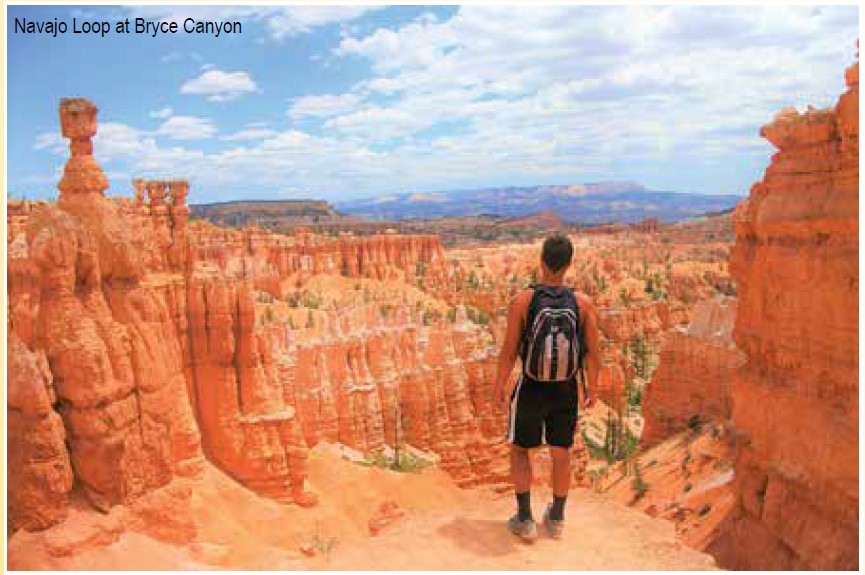
If you have a little more time, I recommend you continue east on Utah State Highway 12 from Bryce and be rewarded with views from a “million-dollar highway,” one of the most scenic drives through the Grand Staircase National Monument that rivals our very own California Highway 1. Trust me on this.
July 12–14: Salt Lake City and Park City, Utah
Utah’s capital, Salt Lake City, is the main cultural and political center of the region. Just west of the city lies the Great Salt Lake where the smell of sulfur is as prevalent as the salt beds. Although it is an interesting place to visit, we chose to go east to Park City, a well-known ski haven during the winter months. Summer months, however, are vastly different with hiking trails leading to numerous beautiful, hidden, alpine-like lakes that turn golden come autumn.
Approximately 10 miles south of Park City, we swam at a unique geothermal spring inside a 55-foot limestone dome called Homestead Crater. The warm mineral water rejuvenated our aching bodies from the rigors of Zion and Bryce and an added bonus: our skin also felt more smooth and supple. After our swim, we were ready for the next adventure.
July 14–15: Jackson Hole and Grand Teton National Park, Wyoming
From Salt Lake City we headed north on I-15 towards Jackson Hole and Grand Teton National Park. From Idaho Falls we took U.S Highway 26 east to Idaho Highway 31, then to Idaho Highway 33, which becomes Wyoming Highway 22, and finally to U.S. Highway 191 to Jackson Hole. This back-country journey through rich green mountains, valleys, lakes, and rivers had spectacular summer views all around with acres and acres of yellow wildflower fields covering entire hillsides. This was quite a contrast to the dramatic red rock mountains and cliffs at Zion and Bryce.
Like Park City, Jackson Hole is a valley well-known for winter sports with amazing ski runs draped on its mountainsides. Right outside of the historic and charming town Jackson, visitors can see large herds of elk grazing on summer greens at the National Elk Refuge. Unfortunately, instead of herds, we saw hordes of tourists not social distancing and not wearing masks, so we decided to keep on driving on U.S. Highway 191 north to Grand Teton National Park.
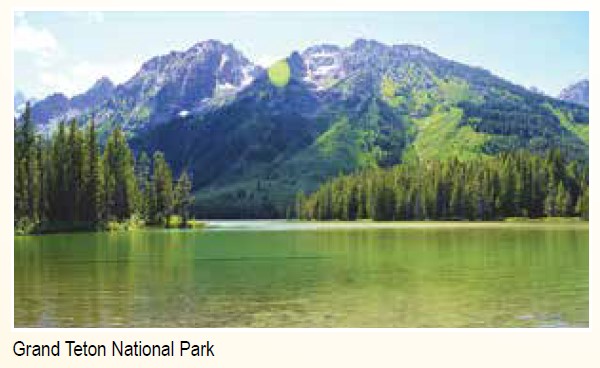
Grand Teton National Park is named after a series of mountain peaks with 11 glaciers called the Tetons. The majestic glacier-capped mountain ranges serve as the perfect backdrop to several beautiful, pristine, crystal clear interconnected lakes. Here, hiking trails are abundant and we had enough sunlight to hike almost seven miles around the lakes to the foot of the Teton mountains. Everything was going swimmingly until we realized we left the bug spray in the car … .
July 15–16: Yellowstone National Park, Idaho, Montana, and Wyoming
Immediately north of Grand Teton is Yellowstone National Park, a park that needs no introduction. It merits mentioning, though, that Yellowstone straddles two states, Idaho and Montana, but the main park is located in Wyoming. Before diving into our Yellowstone adventures, it should be said that each of the three states had its own COVID-19 rules and restrictions, so we had to make sure we knew which state we were in and which rules to adhere to. To reduce confusion and be safe, we wore our masks at all times, social distanced, and sanitized. This applied to everywhere we went.
We spent the first day at Yellowstone viewing geohydrothermal features, such as geysers, including Old Faithful, mud and boiling pots, steam vents, and hot springs. Some of the thermal features looked dangerous. Others looked crystal blue or emerald green, and extremely inviting for a dip. But, looks can be deceiving. These thermal features can instantly strip living flesh off bones, so beware. Additionally, Yellowstone is also known for active wildlife and we saw several bison, elk, and deer roadside, but no bears and wolves.
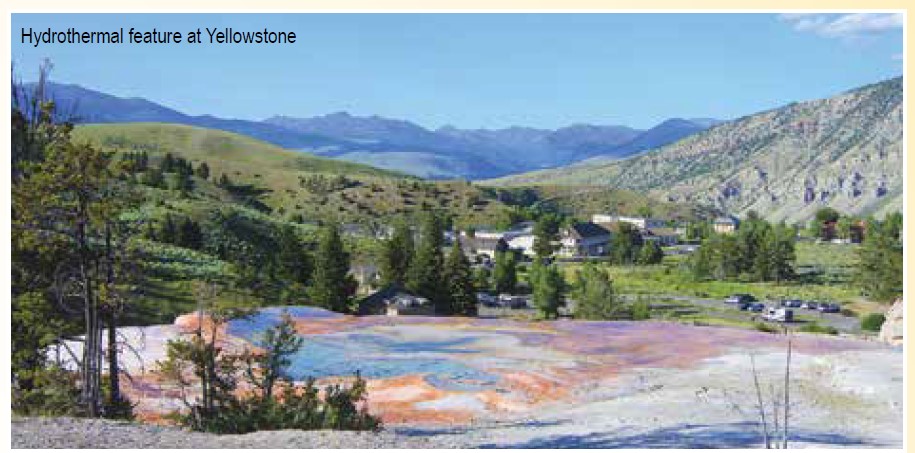
While visiting Yellowstone, we made sure to pack snacks, meals, and lots of drinks in the cooler for two reasons: destinations are generally far from villages where food and drinks are available for purchase; and we saw long, long lines at pretty much any open takeout eatery and store.
Our second day at Yellowstone was very water-oriented. First, we frolicked in the Madison River, and by frolicking I meant dipped our toes in the very, very cold water, skipped stones, and walked along the riverbank wishing the water was warmer. Then, we hiked the rim of the “Grand Canyon of Yellowstone” to view the largest waterfall in the park, Lower Falls of Yellowstone River.
Finally, we rented a boat and cruised around Stevenson Island on the northern end of Yellowstone Lake. Unfortunately, no fishing boats were available for us to fish for lake trout, a delicious and super easy to catch invasive species that park rangers and staff encourage visitors to help remove. On my last visit, with the help of our fishing boat captain, I caught a near five-pound lake trout within 10 seconds. I kid you not! In fact, the six-year-old little girl on a boat next to us was pulling up a fish every 4–5 minutes. If you love to fish and have little patience like me, Yellowstone Lake is the place for you!
July 16–17: Cody, Wyoming
After a long second day at Yellowstone, we drove approximately 76 miles east to a historic cowboy and rodeo town, Cody, Wyoming. The drive through eastern Yellowstone to Cody was haunting with dead, burnt remnants of a once vibrant forest.
Cody, also known as the rodeo capital of the world, hosts an annual three-month-long summer celebration rodeo from the beginning of June to the end of August. A fun fact we learned is that the very first Cody Rodeo start date and year coincided with the grand opening of Yellowstone’s east entrance on June 23, 1919.
In Cody, we stayed at the historic Buffalo Bill Cabin Village, where all rooms are original cabins dating back to 1919 when cowboys stayed during the rodeo celebration as well as people coming to and through this western frontier.
July 17: U.S. Hwy 14, Wyoming and Mount Rushmore, South Dakota
From Cody, we took U.S. Highway 14 east towards I-90 into South Dakota. Hwy 14 turned out to be another picturesque back country highway with dramatic landscapes and sceneries including deep canyons, mountain plateaus of Big Horn National Forest, colorful rock formations, and farmland valleys seen from 8,000 feet above sea level.
We arrived at Mount Rushmore National Monument in South Dakota around 5:30 pm. Although a little late, we found easy parking and a smaller than normal crowd. Mount Rushmore is a what you see is what you get destination. There are no frills and thrills. We took pictures, hiked the somewhat easy 1-mile loop, visited the museum, joined in on a social distance ranger talk, and sampled the Thomas Jefferson vanilla ice cream (the first ever ice cream recipe) all under two hours.
Our unfortunate observation at Mount Rushmore was that the majority of the visitors chose not to wear a mask and made little attempts to social distance, although the staff all wore masks. We steered away from the crowds, but it was a disturbing and disappointing sight during the pandemic.
July 18: Badlands National Park, South Dakota and Omaha, Nebraska
After a good night’s rest, we got up early and headed to Badlands National Park. This vastly underrated national park features pastel color painted hills, pink rock formations, and herds of bighorn sheep grazing on grassy plains on wide open plateaus. But don’t judge this book by its cover. The palate landscape is not fit even for the most fit. Here, life is a constant struggle with next to no water source. In the last couple of centuries, thousands of people including Native Americans sought to conquer the deceptively arid land to no success. Eventually, every tribe and frontier settler abandoned hope and life on these beautiful grounds, hence aptly named Badlands.
By noon, we headed out of Badlands, continued east on I-90, and turned south at Sioux Falls onto I-29, driving alongside Missouri River into Iowa. Just south of Sioux City, in a town called Sergeant Bluffs, we pulled into the upcoming rest area. By happenstance, the rest stop commemorates the historic Lewis and Clark expedition up the Missouri River exploring unchartered western frontier. The rest stop, appropriately named “Corps of Discovery,” featured beautiful tile murals and historic accounts of the expedition with replicas of tools and modes of transport. This “on a whim” stop embodied the spirit of a road trip, discovering new and hidden points of interest unmarked on any map.
At 9 pm, we finally made it to our overnight destination, Omaha, Nebraska. Of course, while in Omaha we had to have Omaha steak, thanks to the far-reaching marketing of said steak.
July 19: Travel Day—from Omaha, Nebraska, to Toledo, Ohio
This was the longest one-day continuous drive on our trip. It took us just over 12 hours to complete 700 miles. We passed through and saw the golden dome of Iowa’s capital, Des Moines. We crossed the Mississippi River at Quad Cities on the border of Iowa and Illinois. We made a pitstop 20 miles south of Chicago and ate White Castle mini burgers, a must when traveling to the Midwest. This was also where we got an EZ-Pass in order to freely travel on all toll roads, bridges, and tunnels in 16 participating states from the Midwest to the Atlantic Coast. Finally, we waved at the Fighting Irish of Notre Dame in South Bend, Indiana, before arriving at our hotel in Toledo, Ohio.
July 20: Cleveland, Ohio, and Niagara Falls, New York
On the 16th day of our trip, we couldn’t resist stopping in the city LeBron James affectionately calls “The Land,” Cleveland. We found our way to the West Side Market because we really, really wanted to try jumbo gyros from Steve’s Gyros featured on Man Versus Food. We were not disappointed. The mere $11 jumbo gyro was ginormous, around 3 pounds, perhaps, and absolutely delicious! Let’s just say I ate almost the entire thing. We also discovered the historic West Side Market had an abundance of dessert shops full of lip-licking delectable sweets on display. The temptation was just too great and we faltered in our feeble attempt to abstain. Resistance was futile.
After gaining presumably 5 pounds each, we took the downtown skyway with Lake Erie below and beyond on our left and the sky reaching commercial center to our right. Drew Carey was correct in touting Cleveland as a place worth the visit.
Hugging the east bank of Lake Erie, we eventually passed through Buffalo, New York, and arrived in Niagara Falls. I remembered my first visit to Niagara Falls fondly 25 years ago. Back then, I only saw the falls from the top, and from only one viewpoint. This time, we walked the entire state park including the Three Sisters Islands, and took the elevator to the bottom of the falls for a completely different, but more invigorating and soaking wet, perspective.
Because the state of New York only allowed Californians to pass through, we cancelled our hotel and re-routed to a former oil boomtown, Bradford, Pennsylvania, just south of the state border.
July 21: Boston and Harvard University, Massachusetts
The drive from Bradford to Boston had us weaving back and forth between New York and Pennsylvania. The interstates on the East Coast are narrower than ours in California and the scenery during the heart of summer was that of lush green foliage of deciduous forests compared to our darker and more towering evergreens.
We finally arrived in Boston around 6 pm, just in time for a New England clam bake, clam chowder, and lobster roll dinner at the waterfront district. Hey, when in Rome. After a meal fit for Aquaman, we strolled through downtown Boston taking in the charm and character of 17th and 18th century town halls under a canopy of 21st century skyscrapers, through the famed Boston Common and Chinatown, and ended at the Boston Tea Party floating museum. For those U.S. history and culture buffs, this is the city to visit.
At nearly 11 pm, instead of going to our hotel, we headed to nearby Cambridge, home to the most prestigious university in the world, Harvard, because we wanted to feel that ivy league glory, tradition, and history. Standing proudly on Old Harvard Square, established in 1636, instantly increased our IQ, social and political position, as well as our snooty status. It’s like being chauffeured in a Rolls Royce convertible waving to the commoners. We really wanted someone to come up and ask, “You got into Harvard?” And us responding, “What? Like, it’s hard?”
July 22: New Haven, Connecticut, New York City and Philadelphia, Pennsylvania
Although Connecticut and New York are pass through states for Californians, we were able to order takeout at the famed Sally’s Pizza in Little Italy, New Haven. Our very large, 16-slice really thin and crispy New York style pizza was arguably the best pizza we’ve ever had. I force-fed myself five slices while my traveling buddy who shall remain nameless ate the remaining 11, including the box because it was that good.
As much as my buddy wanted to see, feel, and taste the Big Apple for the first time, we could only do the next best thing, take pictures from inside the car. We drove through Yonkers and Harlem, around Central Park on Park Avenue, and in front of Time Square before a severe thunder and lightning storm forced us to leave New York City in a hurry. For those in the know, the “major” storms we get here in California pale in comparison to the sheer force of an Eastern and Southern storm. Griping my steering wheel tightly, we very slowly made it out of the storm. This small portion of our road trip was both harrowing and exhilarating, taking some of our senses to all time heights.
Our journey through six states on this day ended in Philadelphia, where we searched the city for the tastiest cheese steak sandwich. Alas, we found Dalessandro’s Steaks, and after inhaling a super beefy $10 footlong, we both agreed the cheese steak was well worth the search. By now, we’ve noticed prices for many, many things on our road trip were quite a bit less than what we’d pay for in California.
July 23: Valley Forge, Pennsylvania, Rehoboth Beach, Delaware, and Chesapeake Bay
Valley Forge is one of several Revolutionary War battle-towns in Pennsylvania with a state or national park commemorating their bloody past and our forefathers who made the ultimate sacrifice for our freedom. Although we didn’t get a chance to visit Independence Hall and the Liberty Bell in Philadelphia, walking the grounds of Valley Forge gave us chills and helped us appreciate our history and the lives lost for us to be Americans.
Our next stop is the resort town, Rehoboth Beach. In all of my travels, I’ve been to many, many beautiful resort beach towns throughout the U.S., the Bahamas, Mexico, Thailand, Australia, and Vietnam. The list is actually pretty long. But this would be my first foray into an eastern seaboard resort beach town. My honest impression was Rehoboth is a quaint and picturesque vacation spot for people from local states. The waves were calmer than that of California and the water warmer. And an added bonus: I learned Rehoboth Beach is an LGBT friendly destination.
From Rehoboth, we followed the Atlantic coastline down to Bethany Beach and then turned slightly inland to U.S. Highway 13 from Ocean City. This drive reminded me of the beach resort coastal strip in South Florida. We continued south on U.S. Highway 13 until the pavement became the iconic 20-mile Chesapeake Bay Bridge-Tunnel. Basically, the highway weaves in and out of the bay transitioning from bridge to tunnel to bridge three times over. When we were above water, we felt like our car was floating on the bay with the horizon going on forever. When we were below water, there was an eerie silence and calm not unlike the dead of night.
With so many stops on this day, we didn’t arrive at our hotel in Winston-Salem, North Carolina, until 2 am the next day.
July 24: Great Smokey National Park, North Carolina, and Tennessee
Due to the late or early arrival to our overnight destination, we got a late start and didn’t get to the Great Smokey Mountain National Park North Carolina entrance until 4 pm. Fortunately, there was plenty of daylight for us to see all the highlights of this popular park. True to the name, our drive to the summit went from sunny and bright to misty and foggy, resembling a smokey condition, in a matter of seconds. We even joked that we were at Golden Gate Park back home in San Francisco. From afar, we could see the smoke hanging over the mountain peaks and draped over to the edge of the canyons below. Again, this sight seemed awfully familiar, a little bit of déjà vu.
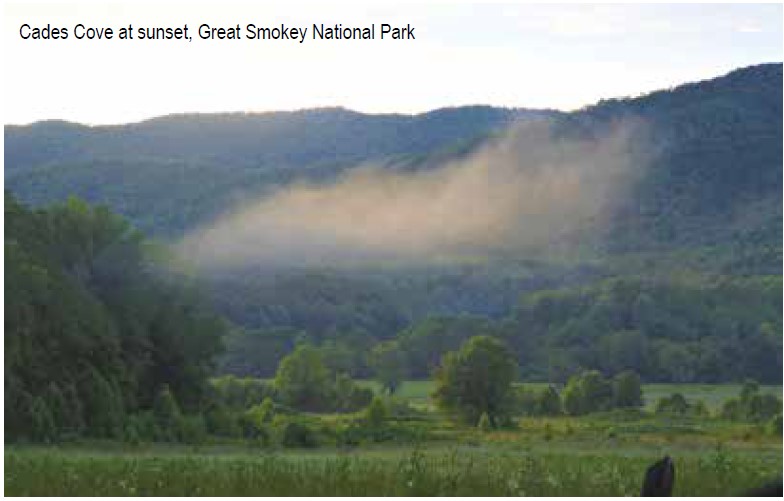
On the other side of the summit is Tennessee and the part of the national park where wildlife viewing at Cades Cove is the main attraction. Fortuitously, getting to the Great Smokey Mountains in the late afternoon coincided with the time of day when wildlife are out in full force, grazing, foraging, and hunting. At Cades Cove, we spotted many white-tailed deer and a very large elk buck with impressive antlers. More exciting was catching multiple bears foraging along the road causing traffic jams.
July 25–26: New Orleans, Louisiana
After breakfast at the Waffle House, another must if you are east of the Mississippi River, in Cleveland, Tennessee, we hopped onto I-59 heading towards the heart of the Deep South. We first passed through Georgia, then Alabama, followed by Mississippi, and finally to Louisiana. We did stop along the way to get gas, drinks, and snacks.
Normally New Orleans, the Big Easy, is packed with jovial and mostly drunk tourists partying just to party. Also known as the “festival capital,” the city celebrates an average of two festivals per week ranging from the biggest Mardi Gras to all types of music, food, art, and cultural celebrations, such as the Voodoo festival. Not only is New Orleans home to amazing creole and Cajun cuisine, jazz music, Bourbon Street in the French Quarter, and the Sugar Bowl, but it is also where the legend of vampires in the United States began.
Our visit to New Orleans during the pandemic saw a desperate and struggling city, trying to cope and survive life with few visitors and numerous restrictions. On a hot summer Saturday night, we counted only several hundred people on Bourbon Street when there should easily be thousands. At a once popular restaurant, we sat in a large outdoor patio alone. The despondent owner couldn’t hide his frustration and disappointment as he pleaded with us to tell our friends to come visit New Orleans.
July 26–27: Austin, Texas
On our way to Austin from New Orleans, we drove through the fourth largest city in the U.S., Houston, Texas, where we did stop at a Whataburger because so many visitors to California rated Whataburger hamburgers higher than our California’s very own In-N-Out. Our verdict? Let’s just say the out of state burger, although not bad, didn’t measure up to our home-grown burger.
So, I can’t in good conscious go to Austin without getting in line at 8 am and wait 3–4 hours for a Franklin BBQ brisket. Yes, it’s the best brisket in the world. Hands down. Luckily, during the pandemic, I ordered the minimum 3 pounds of meat four days in advance online, selected a pick up time, and voila, I savored the world’s greatest brisket without the wait! Although our visit to Austin was short, we did drive by the capital, cruise around downtown, see University of Texas from a block away, get a haircut, and eat doughnut burgers. Oh, and we got gas at $1.69 a gallon!
July 27–28: San Antonio, Texas
A short one-hour drive down I-35 from Austin is San Antonio, where we “remember the Alamo.” What most people don’t know is that a significant part of American southwest history is rooted in or near San Antonio, where several violent and bloody battles took place for a major prize: the state of Texas.
Aside from the Alamo historic site, we strolled nearly 8 miles up and down the famed River Walk. The San Antonio River Walk is unique because the 15-mile long walkway alongside the San Antonio River banks is one floor below city streets with shops, restaurants, art galleries, historic museums, and five missions that have been named World Heritage Sites.
July 28–29: El Paso, Texas
This was my third trip to El Paso. I never thought that I would ever visit this city multiple times, and yet there we were. My first time to El Paso was on a cross-country road trip from California to Florida, one way. On that trip, I merely stopped, ate, rested, and moved on. My second trip was to the Sun Bowl, located at the University of Texas, El Paso (UTEP), because UCLA football, my alma mater, had been selected to play against Virginia Tech University.
El Paso borders Mexico and Ciudad Juarez, the largest city in the Mexican state Chihuahua. I learned some interesting facts about El Paso and Ciudad Juarez on my visits. First, El Paso is the only city in Texas on Mountain Time and not Central Time. It’s neighbor Ciudad Juarez eventually converted to Mountain Time as well. The Franklin Mountain State Park with the tallest peak at nearly 8,000 feet above sea level is located in the center of El Paso, dividing the city into several regions. Erected on the border of Mexico and the U.S., in Ciudad Juarez, stands a 200-feet-tall X marker monument to remember the blood spilled from the violent Juarez drug wars. Whether during daylight or the darkness of the night, the bright red X marker can be seen from almost anywhere along a 5-mile stretch on I-10 near downtown El Paso.
July 29–30: Phoenix, Arizona
The drive on I-10 through the desert Southwest from El Paso to Phoenix was somewhat uneventful. There were a few excellent destinations we could’ve visited, such as Saguaro National Park and the Arizona-Sonora Desert Museum near Tucson, Arizona, but we decided against it mainly due to travel fatigue. We wanted Phoenix to be a recharging and rejuvenating stop before coming down the home stretch.
In Phoenix, I did meet up with a long-time football buddy for a safe and social distance dinner to catch up on old times and drove around the campus of Arizona State University.
The next morning, we went for a hike to Hole in a Rock at Papago Park. It was a relatively easy 1-mile roundtrip hike up the rock with panoramic views of the Phoenix metropolitan area including downtown and the nearby Dessert Botanical Garden, which I highly recommend for those visiting Phoenix.
July 30: Sedona, Arizona
Sedona, located in the heart of Red Rock State Park, is one of the most picturesque towns in the United States, if not around the world. Situated on a pine forest valley floor surrounded by massive, mountain-height red rock cliffs and buttes, Sedona feels like found paradise. There was so much to see and so much to hike and so little time. We partially hiked three popular trails with stunning scenery: Fay Canyon, Airport Mesa, and Devil’s Bridge. Although this was my third time to Sedona, I am still enamored with it and I still found several new and breathtaking things to do and see.
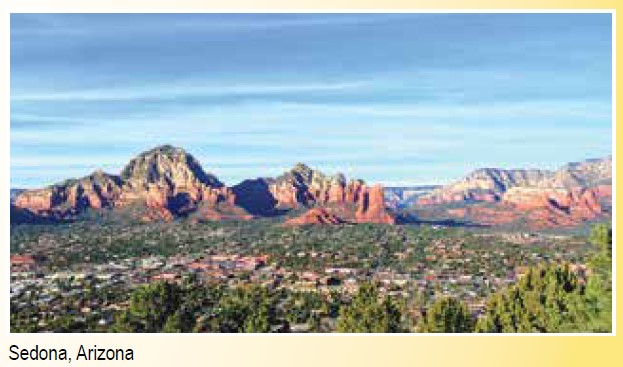
July 31: Slide Rock State Park, Oak Creek Canyon, and Horseshoe Bend, Arizona
We got up extra early and headed to Rock Slide State Park from Sedona because, due to the pandemic, the park is severely limiting the number of visitors. Arriving a little before 8 am, we were one of the final four vehicles to be let in before the gates closed. Slide Rock State Park is a natural narrow canyon water slide carved out by the fast-moving Oak Creek over hundreds of thousands of years. People of all ages and backgrounds come to Slide Rock for the natural beauty, to go down the water slide, swim, and rock jump into the cool, if not cold, snow melt water. And we did all of that.
After a couple hours of frolicking at Slide Rock, we headed north and followed the road through the enchanted Oak Creek Canyon. After a beautiful 8-mile drive, the road zig zagged up a steep yellow granite mountainside to the top where the view of the entire Oak Creek Canyon all the way to Sedona can fit into one regular photo frame.
Continuing north through Flagstaff on U.S. Highway 89, we stopped at one of the most photographed sites in the U.S., Horseshoe Bend. As advertised, the Colorado River bends beneath a steep and almost vertical granite butte, much like a horseshoe. The contrast between the emerald green river against the salmon-pink rock walls was stunning.
July 31: Marble Canyon, Vermillion Cliffs National Monument, and Grand Canyon North Rim, Arizona
From Horseshoe Bend we drove through a slew of stunning landscapes, something we didn’t plan or expect, on our way to the Grand Canyon. Traveling west on U.S. Highway 89A, we first came to Marble Canyon on the western border of the Navajo Nation. We made a pitstop at the historic Navajo Bridge crossing the Little Colorado River.
Further down on the highway, through a 28-mile stretch of House Rock Valley, we encountered a few abandoned centuries-old Navajo cliff and rock dwellings. We were amazed at how the Navajos carved out life from such barren and arid, but beautiful, lands.
For much of our drive on U.S. Highway 89A, the road moved in parallel with Vermillion Cliffs National Monument. This geological wonderland is all wild with no marked trails, no visitor centers, and no official campgrounds. The 3,000-feet-high cliffs span an area of near 300,000 acres with waves of striated red, orange, and goldish-yellow sandstone.
From U.S. Highway 89A we eventually turned left onto Arizona Highway 67, the one highway in and out of the Grand Canyon North Rim. An important note: this Arizona highway and the North Rim is only open from May through October every year. Finally arriving at the much less fanfare Grand Canyon North Rim around 5 pm, we immediately jumped on the main canyon view hiking trial, Bright Angel Point Trail. Be forewarned: this trail, although steeped with magnificent and majestic sweeping views everywhere, is not for the faint of heart. There are no handrails and no protective barriers. It’s you, the trail, and a 5,000-foot drop to the canyon floor on both sides!

After watching a serene and colorful sunset, we headed out of North Rim in total darkness. I parked on the side of the road, turned off the engine and lights, opened the moon roof, and we sat back and counted the stars and pointed out constellations. We then retraced the highway back out of Grand Canyon. Not more than a few miles later we came to a sudden screeching halt as a herd of large buffaloes blocked the entire width of the highway. Unfazed by our high beam headlights shining brightly on their massive torsos, the buffaloes ignored us and continued their business. After a few anxious moments, we found a small opening and squeezed our car through.
Getting back to the U.S. Highway 89A junction, we turned left and headed towards our overnight destination, La Verkin, Utah, where when we were asked about the beauty of Hwy 89A several times, our answer was simple: it was absolutely gorgeous east of Arizona Highway 67. As for the western part? We didn’t see a thing in the dark.
August 1: Virgin River, Red Cliffs National Conservation Area, Utah
Before getting on I-15 heading to Las Vegas once again, we decided to take an unplanned side trip to a popular trailhead, Babylon Arches, approximately 10 miles from La Verkin. The road leading to the trailhead went from paved to gravel to dirt to sand. There were no vehicular restrictions or warnings anywhere, so we proceeded. The signs directing visitors to Babylon Arches virtually disappeared after a couple of miles into Red Cliffs National Conservation Area and Google maps led us to the middle of nowhere until the sandy road ended at the Virgin River. To our surprise, this part of the river was stunning. On the other side of the warm, pristine pastel green water stood several 70-foot, vertical, deep orange, granite-like rocks. We thought to ourselves, this was what a road trip is all about, discovering the beauty of road less traveled.
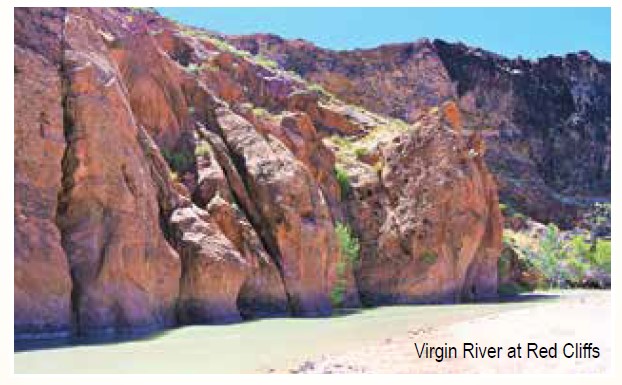
After wading and playing in the shallow river for an hour, the hot morning sun quickly elevated to an oppressive midday heat in excess of 110 degrees Fahrenheit. Turning our car around, we found ourselves disoriented, unable to recognize which sandy road we came from. Unfortunately, I chose the one on the left and drove right into a sand pit.
With no one around to help us, we tried every trick in the book to get us out of the sand trap to no avail. Using a minimal cell reception, we were able to contact AAA for assistance. And for about an hour, all in our world was well because a tow truck was on its way.
During this time, a family of seven, Julianne Seymour and her six kids, came rumbling down in their 4×4 SUV. We struck up a conversation, and a friendship was forged. Shortly after the family left, we got a call from the towing company informing us the truck will take at least 3 more hours to get to us. Upset, we decided to make a last-ditch, all-out physical effort to get us out of the trap, but the car would not budge. Now we were dead tired, overheated, and running low on water. We were alone and started to get desperate.
Luckily, the Seymour family got worried because they didn’t see us leaving and came back to check on us. The entire family helped dig, push, and pull for nearly an hour until we were finally out of the sand trap. Suffice it to say that we were extremely grateful and relieved. Amidst this pandemic and our country in disarray, we discovered that people do care and are very willing to help one another!
August 1–3: Las Vegas, Nevada
After our harrowing experience in Southern Utah, we decided we needed a break from traveling and spent the next two nights in Las Vegas, where we ate, sat by the pool, ate, slept, and repeated.
August 3–5: Los Angeles, California
It’s nice to be back in our Golden State where the sun’s warmth hugs us. In Los Angeles, we went to the beach and played a social distance sport, tennis. It is the Southern California lifestyle even during a pandemic.
Of course, there’s much more to do in Los Angeles than just going to the beach. We took advantage of the recent opening of the venerable Huntington Library and Gardens, the only place I am aware of that has the original Gutenberg Bible, printed in 1397, on display. Huntington is also unique because the grounds house 16 major international and ecosystem gardens, including a $10 million Chinese Ming garden, a 1,200 variety of roses garden, and a Japanese garden with a 320-year-old house.
Although we stretched our trip an additional five days, it was time to head home where our home, beds, and loved ones await.
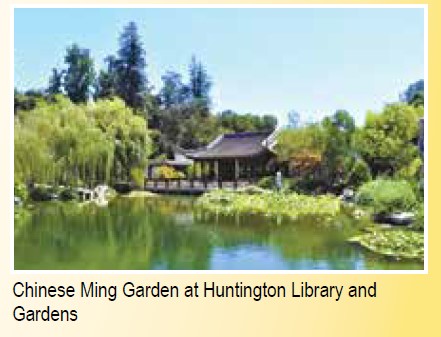
After 32 days and 10,300 miles on the road, we finally made it back to our beloved San Francisco Bay Area. Overall, we traveled to 30 states including 10 capital cities, visited nine National Parks and Monuments, walked and hiked a little over 120 miles, endured at least 12 days of oppressive heat with temperatures of 108 to 118 degrees Fahrenheit, and checked off 11 bucket list items.
In addition, we drove through an extreme thunder and lightning storm, survived a sand pit, skirted a hurricane, and nearly plowed into a herd of buffalo. Most importantly, we learned a lot about our country and our people during a pandemic. The vast majority of the people adhered to safe practices and social distance protocols whenever possible. Businesses such as shops, restaurants, and hotels took great care to clean and sanitize. On our trip, we never felt unsafe or threatened.
In my opinion, if we do everything in our power to be safe by wearing a mask, washing hands and sanitizing many times over, avoiding crowds, and social distancing, a road trip is a great way to invigorate and rejuvenate our passion and thirst for life.
John Chen, a UCLA alumnus and an avid sports fan, has competed as well as coached tennis, volleyball, softball and football teams.
Published on September 24, 2020
Recent Comments